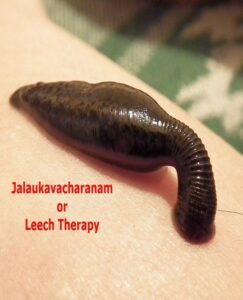Leech therapy in Ayurveda treatment for eye disease
Introduction
In Ayurveda, Leech therapy (Hirudotherapy) is a minimally invasive, natural, parasurgical procedure for the management of eye diseases. It is the process of removal of vitiated Dosha in the body. The treatment is a safe, cost-effective, almost painless method for all kinds of inflammatory diseases of the eye like Conjunctivitis, Schleritis, Keratitis, Glaucoma, periorbital hematoma, etc.
Leech therapy is a traditional medicinal therapy usage that has been mentioned vividly in Ayurveda, Greek, Arab, and Russian medical systems. Recently there have been successful treatments by Leech therapy of different eye diseases in India, Germany, Russia, and the UK. Ophthalmologists have been successful in curing Inflammations of the eyes, periorbital hematoma, keratitis, chorioretinitis, diabetic retinotherapy, macular degeneration, retinitis, glaucoma, subretinal hemorrhage, and cataract. In India, Leech therapy is also being practiced in some clinics across metropolitan cities like Delhi, Noida, Gurugram, Nagpur, Pune, and Mumbai.
History
The importance of leech therapy in Ayurveda can be estimated as Lord Dhanvantari, the father of Indian medicine holds leech in his hand. Acharya Sushruta, Father of Plastic Surgery, has described a complete chapter on Jalaukas (Leeches) and Jalaukavacharaniya (bloodletting) in Sushruta Samhita. Because of its therapeutic effects, this therapy is successful even today.
Leech Therapy (Jalaukavacharana) is the most popular method of Raktamokshana to describe localized blood-letting. In Sushruta Samhita, the details of the eye diseases have been described in detail in Uttartantra.


Leeches (Jalauka)
The word leech has been derived from ‘laece’ which means physician. Leeches are also called Jalauka for the fact that their site of dwelling and their source of nutrition is Jala. Leeches are blood-sucking annelid worms with the ability to detoxify the blood.
According to Sushruta Samhita, 12 types of leeches found were classified into non-poisonous leeches (nirvisha jalauka) and poisonous leeches (savisha jalauka). There are around 700 leech species found globally, out of which 15 species of Leeches that are most common for therapeutic purposes are Hirudo medicinalis (India), Hirudo verbena, Macrobdella decora, Hirudotroctina, Haementeria officinalis, Hirudo quinquestriata, Hirudo nipponia, Hirudinaria manillensis, Poecilobdella granulose, and Hirudinaria javanica.
Poisonous Leeches are not suitable for Leech therapy. Non-poisonous leeches that are bulky, stout, fast blood-suckers and dwelling in freshwater are suitable for Leech therapy.
Leeches have two sucker parts which work for creeping and attachment. The front one has three jaws which include many teeth. They usually bite warm parts of the host and sucking of blood is through rhythmic contractions. Feeding generally takes almost an hour and a leech digests 10–15 mL of blood per feeding.
Bioactive constituents of Leech Saliva
Different bioactive constituents present in Leech saliva leads to therapeutic effect. The major bioactive constituents are Hirudin (anticoagulant effect), Calin (anticoagulant effect), bioactive substances inhibiting collagen, Destabilase (thrombolytic effects), Hirustasin (enzyme inhibiting effect like trypsin), Bdellins (anti-inflammatory), Hyaluronidase (antibiotic), Tryptase inhibitor, Eglins (anti-inflammatory), Factor Xa Inhibitor, Complement inhibitors, Carboxypeptidase A inhibitors, Histamine-like Substances (vasodilator).
Mode of action
Leeches saliva contains bioactive substances which include antiplatelet aggregation factor, anti-inflammatory, anesthetic, and antibiotic agents. Due to the sucking of excess blood by the Leeches, the swelling is reduced and fresh oxygenated blood is supplied to the affected region ultimately restoring the natural circulation. It helps in healing the body part and increases the immunity of the body.
Bioactive substances present in leech saliva helps the cells in the absorption of essential nutrition and remove toxins.
Glaucoma and Leech therapy
Glaucoma, an eye disease, is the second most common cause of blindness worldwide. In India, glaucoma is the main cause of irreversible blindness with around 12 million people affected, and about 1.2 million people getting blind from the disease. It is related to the damage of the optic nerve due to increased intraocular pressure (IOP) which can lead to loss of vision and even blindness.
Treatment of glaucoma by Leech therapy allows sucking of vitiated blood along with toxins and reduces the intraocular pressure and maintains the ideal atmosphere inside the eye. Leech saliva contains hirudin, anticoagulant proteins, and histamine-like bioactive substances which are useful in restricting the pathophysiology of Glaucoma.
Contraindications of leech application
Leech therapy is restricted to be performed in patients suffering from generalized anasarca, emaciated, swelling, anemia, ascitis, and in pregnant women.
Risks associated with Leech therapy
Leech therapy has no side effects however there is a small risk of Infection (2.5-20%) of bacteria (Aeromonas hydrophila) present in their gut. The use of suitable antibiotics can solve the complication. Also, a certain degree of blood loss has been reported which may require transfusions.
Conclusion
The management of eye diseases by the modern medical system without any side effects is still a challenge. Leech therapy’s importance can be easily recognized because of the remarkable results and its efficacy in curing a wide range of ophthalmic diseases and many other diseases.



